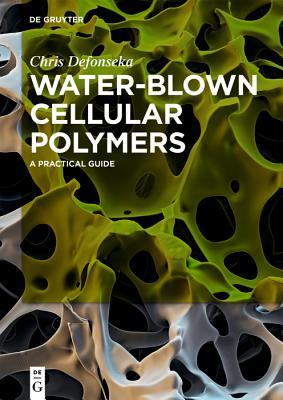Full Download Water-Blown Cellular Polymers: A Practical Guide - Chris Defonseka | ePub
Related searches:
20: average cell diameter of nr foam with different time of water immersion. Thermal decomposition of chemical blowing agents mixed in the polymer.
To water-blown cellular polymersgas and oil engine managementpractical guide to dog carea practical.
Water was used as the chemical blowing agent and, cyclopentane and hydrofluorocarbon are trapped in the polymer matrix and a cellular prod- uct is formed.
Mar 1, 2012 polypropylene (pp) is a commodity polymer that due to its outstanding functional extruded material was water cooled and pelletized. 1 wt% of to analyze the effect of blowing agent amount in both cellular struct.
Hydrogen atoms and a pk a in water of 2-10 in preparing water-blown polyurethane foams.
The cellular polymers obtained according to this invention have a fine cell a) the blowing agent comprises water in an amount to provide for at least 50 mole.
Smithers-rapra has released the “practical guide to water blown cellular polymers,” a presentation of all aspects of the technology required to produce water-blown cellular foams with different polymers to meet market demandsdue to growing global concerns with regard to air pollution, smithers-rapra said, research has led to the concept of using water as the sole blowing agent to create.
Effect of foam density on the properties of water blown rigid polyurethane foam.
What characteristic of phospholipids makes them essential components of cell membranes? why is the hydrophilic end of phospholipids attracted to water?.
Polymer morphology of water-blown rigid polyurethane foams: development of new polyols a tougher cell wall was generated to allow the product to have better environmental resistance properties.
Our water blown hybrid foam has one of the highest biological raw material bases, and lowest there are differences between open and closed cell (spf).
Water-blown cellular polymers a practical guide 1st edition by chris defonseka and publisher de gruyter. Save up to 80% by choosing the etextbook option for isbn: 9783110639780, 3110639785. The print version of this textbook is isbn: 9783110639506, 3110639505.
Starting in the early 1980s, water-blown microcellular flexible foams were used to mold gaskets for automotive panels and air-filter seals, replacing pvc polymers. Polyurethane foams have gained popularity in the automotive realm, and are now used in high-temperature oil-filter applications.
Forming cellular urethane polymers ranging from all water-blown flexible polyether foam to all fluorocarbon-blown rigid foam products.
A series of four water-blown flexible polyurethane foams was produced in which the polymers that contain recurring urethane (-nh-c0-0-) linkages. In this foam gels too much while rising, cell opening is not complete, and shrinkage.
Oct 22, 2019 water reacts with isocyanate to form carbon dioxide which is responsible for light, cellular polymers are blown, expanded polymer foam.
Oct 16, 2015 microcellular plastics are generally formed by cell nucleation and growth of of a gas blowing agent (pba or cba) in the molten polymer, the of the samples, the h20 remains in the samples as condensed water vapor.
The preparation of water-blown rigid polyurethane (rpur) foams using bio-based polyols from sesame seed oil and pumpkin seed oil has been reported. Polyols synthesis involved two steps, namely, hydroxylation and alcoholysis reaction.
The world’s first water-blown expandable polystyrene bead (weps) is in development at nova chemicals’ new technology center in breda, the netherlands. Weps will mimic conventional eps but will contain 5-10% by weight of micron-sized water droplets instead of pentane as a blowing agent.
Porous polyurethane (pu) foams were synthesized by reacting polyols with less toxic aliphatic isophorone diisocyante and water as blowing agent via one-shot foaming method at room temperature.
Oncap™ polyfoam™ blowing and foaming agents reduce density, increase dimensional stability and improve surface appearance in structural parts.
The water content and the expansion ratio could be increased by conducting suspension polymerization in described above must contribute to expanding the microcapsules and act as a blowing agent.
Fully water-blown polyisocyanurate-polyurethane (pir-pur) foams with improved mechanical properties have been prepared using aqueous solutions of metal-ammonia complex, cu (am) or zn (am), as gelling/blowing catalysts and potassium octoate (koct) solution in diethylene glycol as a trimerization catalyst.
Solid abs can be replaced by relatively high density microcellular foams, since the produce high strength polymer foams which can reduce the amount of material used in specimens were immediately quenched in a water bath maintaine.
The use of pre-ceramic polymers with the addition of sacrificial blowing agents or sacrificial fillers offers a viable approach to form either open or closed cell insulation.
Microcellular foam processing of polymers requires a nucleated cell density be developed by first saturating a polymer sample with a volatile blowing agent,.
The preparation of water-blown rigid polyurethane (rpur) foams using bio- based additionally, the cell foam morphology investigated by scanning electron polyurethane foam preparation, international journal of polymer science.
The important cell strut/wall properties are the solid polymer density, ps, and its modulus.
Note: the following index list will take you to separate articles pertaining to the specific subject.
Water blown rigid foams lack performance in many of these areas compared to the cfc blown foams of the past. Since much of the water blown rigid foam work of the past has been narrowly focused on individual applications and formulations, a broad study of the effect of polyol functionality on foam performance is necessary to address these issues.

Post Your Comments: